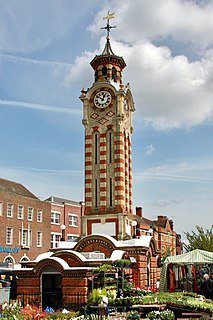
Epsom is the principal town of the Borough of Epsom and Ewell in Surrey, England, approximately 13.5 mi (21.7 km) south of central London. The town is first recorded as Ebesham in the 10th century and its name probably derives from that of a Saxon landowner. The earliest evidence of human activity is from the mid-Bronze Age, but the modern settlement probably grew up in the area surrounding St Martin's Church in the 6th or 7th centuries and the street pattern is thought to have become established in the Middle Ages. Today the High Street is dominated by the clock tower, which was erected in 1847-8.

The Royal Earlswood Hospital, formerly The Asylum for Idiots and The Royal Earlswood Institution for Mental Defectives, in Redhill, Surrey, was the first establishment to cater specifically for people with developmental disabilities. Previously they had been housed either in asylums for the mentally ill or in workhouses.

Caterham is a town in the Tandridge District of Surrey, England. The town is administratively divided into two: Caterham on the Hill, and Caterham Valley, which includes the main town centre in the middle of a dry valley but rises to equal heights to the south. The town lies close to the A22, 21 miles from Guildford and 6 miles south of Croydon, in an upper valley cleft into the dip slope of the North Downs. Caterham on the Hill is above the valley to the west.

Friern Hospital was a psychiatric hospital in the parish of Friern Barnet close to a crossroads which had a hamlet known as Colney Hatch. In 1965, it became part of the London Borough of Barnet and in the early 21st century was converted to residential housing as Princess Park Manor and Friern Village. The hospital was built as the Second Middlesex County Asylum and was in operation from 1851 to 1993. After the County of London was created in 1889 it continued to serve much of Middlesex and of the newer county, London. During much of this time its smaller prototype Hanwell Asylum also operated.
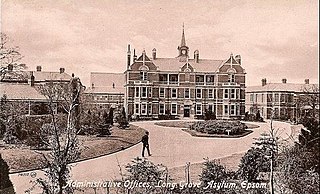
Long Grove Hospital, formerly Long Grove Asylum was a mental hospital, part of the Epsom Cluster of hospitals in the Horton area of Epsom, Surrey in the United Kingdom.
Horton is an area in the west of the borough of Epsom and Ewell in the English county of Surrey. It is situated between Epsom, West Ewell and Chessington. It's principal road is Horton Lane, which runs the length of the area between West Ewell and Epsom Common. Horton covers the west part of the KT19 postcode which comes under part of the Epsom postal area. Horton Country Park also runs along the length of the area, between Epsom Common and West Ewell.
The Horton Light Railway had its origins in a contractor's line built in 1905 to transport building materials, coal and other supplies for London County Council's Epsom Cluster of psychiatric hospitals in the Horton area to the North-West of the town of Epsom. The Light Railway Order did not permit the carriage of passengers. The railway connected with the mainline network just south of Ewell West railway station.

Horton Country Park is a 152.3-hectare (376-acre) Local Nature Reserve in the Horton area north-west of Epsom in Surrey. It is owned and managed by Epsom and Ewell Borough Council.

West Park Hospital was a large psychiatric hospital in Epsom, Surrey.

The Epsom Cluster, also referred to as the Horton Estate, was a cluster or group of five large psychiatric hospitals situated on land to the west of Epsom.

The Park Centre for Mental Health is a heritage-listed psychiatric hospital at 60 Grindle Road, Wacol, City of Brisbane, Queensland, Australia. It is one of the largest psychiatric hospitals in Australia. The hospital provides a range of mental health services, including extended inpatient care, mental health research, education and a high security psychiatric unit. It was designed by Kersey Cannan and built from 1866 to 1923. It is also known as Goodna Hospital for the Insane, Goodna Mental Hospital, Woogaroo Lunatic Asylum, and Wolston Park Hospital Complex. It was added to the Queensland Heritage Register on 21 October 1992.

The Royal Albert Hospital was a hospital in Lancaster, Lancashire, England. It opened in 1870 as an institution for the care and education of children with learning problems. By 1909 there were 662 children in residence. Following new legislation in 1913, adults were also admitted. By the time of the introduction of the National Health Service in 1948 the hospital had 886 patients, and by the 1960s there were over 1,000 patients. Following legislation in the 1980s, the patients were relocated in the community, and the hospital closed in 1996. The building was acquired by Jamea Al Kauthar Islamic College to provide Islamic education for girls. The main part of the hospital is recorded in the National Heritage List for England as a designated Grade II* listed building, and its west lodge is listed at Grade II.

Horton Hospital formerly called Horton Asylum was a large psychiatric hospital in the Horton area of Epsom, Surrey.

St Ebba's Hospital formerly Ewell Epileptic Colony (1904–1918) and later Ewell Mental Hospital (1927–1938) is a mental handicap and former psychiatric hospital near Epsom in the county of Surrey in the United Kingdom.

Middlewood Hospital is a former psychiatric hospital situated between the suburbs of Middlewood and Wadsley in the City of Sheffield, South Yorkshire, England. It was also known as the South Yorkshire Asylum (1872–1888), the West Riding Asylum, Wadsley (1889–1929) and Wadsley Mental Hospital (1930–1948). It was one of four hospitals that made up The West Riding General Asylums Committee. It closed in 1996 and is now a private housing development called Wadsley Park Village.

Roundway Hospital was a psychiatric hospital in the parish of Roundway near Devizes, Wiltshire, England. It was originally called the Wiltshire County Lunatic Asylum and later the Wiltshire County Mental Hospital. It opened in 1851 and closed in 1995.
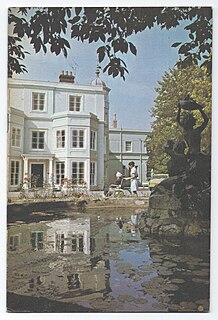
The Old Manor Hospital was a psychiatric hospital in Salisbury, Wiltshire, England. It was established in the early 19th century as a private licensed house called Fisherton House or Fisherton House Asylum, which became the largest private madhouse in the United Kingdom. In 1924, following a change of proprietors, it was renamed Old Manor Hospital and in 1955 it was amalgamated into the National Health Service. From 1813 to 1955 it was owned and managed by members of the same family. The Old Manor Hospital closed in 2003 and was replaced by Fountain Way, a smaller, modern, psychiatric hospital on part of the same site. In 2014 the site was acquired by Quantum Group for development as a residential estate and the conversion of the main building to a hotel.
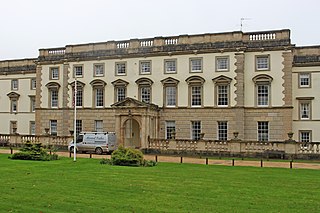
Brislington House was built as a private lunatic asylum. When it opened in 1806 it was one of the first purpose-built asylums in England. It is situated on the Bath Road in Brislington, Bristol, although parts of the grounds cross the city boundary into the parish of Keynsham in Bath and North East Somerset.

Botleys Mansion is a Palladian mansion house in the south of Chertsey, Surrey, England, just south of St Peter's Hospital. The house was built in the 1760s by builders funded by Joseph Mawbey and to designs by Kenton Couse. The elevated site once bore a 14th-century manor house seized along with all the other manors of Chertsey from Chertsey Abbey, a very rich abbey, under Henry VIII's Dissolution of the Monasteries and today much of its land is owned by two hospitals, one public, one private and the local authority. The remaining mansion and the near park surrounding were used for some decades as a colony hospital and as a private care home. The building is owned and used by a wedding venues company.
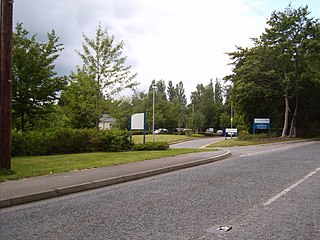
Tatchbury Mount Hospital is a health facility to the north of Totton, Hampshire, England. It is owned and managed by Southern Health NHS Foundation Trust and acts as the Trust's headquarters. The site was formerly a large psychiatric hospital with the majority of the buildings on the site dedicated to this purpose, however in recent years changes in the management of these patients has resulted in the uses for the site diversifying.






















